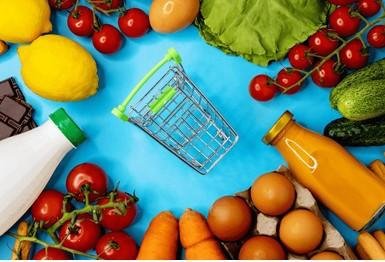Written by: Segun Akomolafe
Grocery shopping is where your health journey begins. What you put in your cart directly impacts what goes into your body. This complete guide to healthy grocery shopping will help you navigate supermarket aisles with confidence, making choices that support your wellbeing without breaking the bank or requiring specialist knowledge.
Before You Shop
Before you decide to go to the market, you need to know what food items are good for your health and well-being. The following are the necessary procedures you should follow before your healthy grocery shopping.

Plan Your Meals
Take 15 minutes before shopping to plan your meals for the week. This simple step prevents impulse purchases and ensures you buy what you’ll actually use. Here’s how to go about it:
- Choose recipes that share ingredients to minimize waste
- Include a mix of proteins, vegetables, fruits, and whole grains
- Consider your schedule – plan quicker meals for busy nights
Create a Strategic List
Organize your shopping list by store layout to save time and reduce impulse buys. Most stores follow a similar layout with produce near the entrance, processed foods in center aisles, and dairy/meat along perimeter walls.
Eat Before Shopping
Never shop hungry. A study in JAMA Internal Medicine found that hungry shoppers purchased significantly more high-calorie foods. A small protein-rich snack before shopping can help you make more rational choices.
Navigating the Store
Here are the quick tips you need to consider while going round the shopping mall to ensure you first buy healthy grocery items on your shopping list:
Shop the Perimeter First
The store perimeter typically contains fresh, whole foods – produce, meat, seafood, dairy – while inner aisles house more processed items. Begin your shopping trip around the edges where most nutritional value exists.
Produce Section Mastery
The produce section offers the most nutritional bang for your buck, so it’s advisable that you get a good mastery of it in order to choose the items that will benefit you properly without going off budget. Here’s what I recommend:
Selecting Produce:
- Choose a rainbow of colors for diverse nutrients
- Look for firm fruits and vegetables without bruises
- Consider seasonality for better flavor and lower prices
- Don’t overlook frozen produce – it may be more nutritious than “fresh” items transported long distances
Money-Saving Tips:
- Buy in-season produce
- Compare pre-cut versus whole produce (whole is typically much cheaper)
- Consider promo programs offering discounted imperfect fruits and vegetables
Protein Sources

The most important source of protein is Animal Proteins, which you can get from lean cuts of meat (round, loin, sirloin for beef, and poultry birds). Eggs offer excellent nutrition at lower prices than most meats. To walk within your budget, consider cost per serving rather than cost per pound. Make sure you also check for sustainable seafood certifications in order to ensure safety.
Another relevant protein source is Plant Proteins. Beans and lentils provide protein, fiber, and nutrients at minimal cost. Tofu and tempeh also offer complete proteins without cholesterol. You can also use nuts and seeds to make excellent protein-rich snacks, such as peanuts and trail mix.
Dairy and Alternatives
I advise you to choose plain yogurt and add your own fruit instead of pre-sweetened varieties. Don’t forget to also compare nutrition labels on plant-based milk alternatives because many of them contain added sugars. Also, during your healthy grocery shopping, keep in mind that cheese can be high in sodium and saturated fat, so opt for stronger flavors where a little goes a long way.
Grains and Starches: Healthy grocery shopping
The best thing is to select whole grains with “whole” as the first ingredient. Then, compare the fiber content – higher is generally better. However, you need to watch for hidden sugars in white rice products and consider cooking time when selecting them for weeknight meals.
Read more: The 10 Best Yoga Mats for Daily Workout
Navigating Middle Aisles During Your Healthy Grocery Shopping
Inner aisles aren’t all nutritional wastelands. Here’s how to find hidden gems:
Canned and Packaged Foods
The first step here is to choose low-sodium or no-salt-added canned vegetables. Select fruits packed in water or juice instead of syrup. Next, look for canned fish like sardines and salmon for economical omega-3 sources. Then, rinse it to reduce sodium and stock up on beans for quick meals.
Oils and Condiments
Extra virgin olive oil offers heart-healthy monounsaturated fats. However, you need to consider specialized oils, such as sesame, walnut for much lower fats. Go for pure condiments with no added sugars.
Frozen Foods
Plain frozen fruits and vegetables often contain more nutrients than fresh ones that have traveled long distances. Scrutinize frozen meals for sodium content and choose simple ingredients with no additives or preservatives.
Label Reading Essentials
Don’t let marketing claims mislead you. The real story is in the nutrition facts and ingredient list.
Nutrition Facts Panel: A Key Factor of Healthy Grocery Shopping
To prioritize nutrition, you need to focus on the following key areas:
- Serving size (don’t serve beyond what you can eat)
- Calories per serving (2,000 for males, 1,600 for females)
- Added sugar content (aim for minimal)
- Fiber content (higher is generally better)
- Sodium (aim for less than 140 mg per serving for “low-sodium” foods)
Ingredient List Decoded
If your weight is over 100kg, avoid products with sugar (or its aliases) in the first few ingredients. Then, be wary of long ingredient lists with unrecognizable items and try to also avoid partially hydrogenated oils (trans fats).
Read more: The Complete Guide to Protein Supplements
Special Dietary Needs
Most of the time, you need to give more attention to your dietary needs rather than your dietary desires. For example, If your blood sugar level is high, it means you can’t eat too much carbohydrate, but you can replace it with more proteins, vitamins, and minerals.
Gluten-Free Shopping
Look beyond specialty products – many whole foods are naturally gluten-free. Beware of cross-contamination in bulk bins. Compare nutrition profiles of gluten-free alternatives to conventional products.
Vegetarian/Vegan Essentials
Focus on whole foods rather than processed meat alternatives. Consider fortified products for nutrients like B12 and vitamin D. Diversify protein sources for complete amino acid profiles.
Low-Sodium Strategies
Fresh and frozen plain produce contains minimal sodium. Compare brands – sodium content varies dramatically. Use herbs, spices, and acid (lemon, vinegar) for flavor instead of salt.
Budget-Friendly Healthy Shopping

Eating well doesn’t require emptying your wallet. The following are some some ways to get healthy diets without breaking the bank:
Seasonal Shopping
In-season produce typically costs less and tastes better. Learn your local growing seasons or check seasonal food guides online. Consider preserving seasonal abundance by freezing or canning.
Bulk Buying Wisdom
Dry goods with long shelf lives (beans, grains, nuts) often cost less in bulk. Calculate price per unit to confirm you’re getting a good deal. Share bulk purchases with friends for variety without waste.
Strategic Store Selection
Discount grocers often offer the same produce at lower prices. Farmers markets sometimes offer better deals, especially at day’s end. Consider ethnic grocery stores for affordable spices and specialty items.
Building a Healthy Pantry
A well-stocked pantry makes healthy cooking easier and reduces the temptation of takeout:
Essential Staples
This includes whole grains: brown rice, quinoa, oats. Beans: chickpeas, black beans, lentils. Nuts and seeds: almonds, walnuts, chia, flax. Canned goods: tomatoes, tuna, salmon. Herbs and spices: build gradually based on preferred cuisines.
Smart Storage
Transfer bulk items to airtight containers to extend shelf life. Label containers with purchase dates. Store nuts and whole grain flours in the refrigerator to prevent rancidity.
Read more: 8 Best Workouts to Keep You Healthy
Embracing Convenience Without Compromise
Modern life demands convenience, but it needn’t come at a nutritional cost. All you need is to develop the healthy time-savers and home strategies explained below:
Healthy Time-Savers
Pre-washed greens should be checked for good value compared to whole heads. Fresh vegetables are often more nutritious than aged “frozen” produce. Canned beans should be rinsed to reduce sodium.
Semi-Homemade Strategies
Doctor up pre-made foods with fresh additions. Mix prepared items with homemade ones and store-bought rotisserie chicken in homemade soup. Keep a few non-perishable items, such as canned beans and fruits for a few days but not months because they may lose nutritional value.
Read more: Top 20 Ways to Relieve Stress and Anxiety
Special Considerations
Here are some good shopping ethics you need to shop appropriately and with less stress:
Shopping with Children
Involve kids in age-appropriate ways (selecting between healthy options). Discuss nutrition in positive terms (Buy food items that make them healthy and not just happy). Consider shopping online to avoid checkout lane temptations.
Food Sensitivities and Allergies
Familiarize yourself with ingredient aliases (casein vs. milk protein). Contact manufacturers when ingredient lists are unclear. Be aware of cross-contamination risks, particularly with nuts and gluten.
Final Thoughts on Healthy Grocery Shopping
Healthy grocery shopping isn’t about perfection – it’s about making better choices most of the time. Each shopping trip is an opportunity to nourish your body and develop habits that support long-term health. Start where you are, implement changes gradually, and remember that small shifts in purchasing habits can yield significant health benefits over time.
By approaching the grocery store with knowledge and intention, you transform a routine errand into a powerful act of self-care. Your cart reflects your priorities – fill it thoughtfully.
Related Contents:
